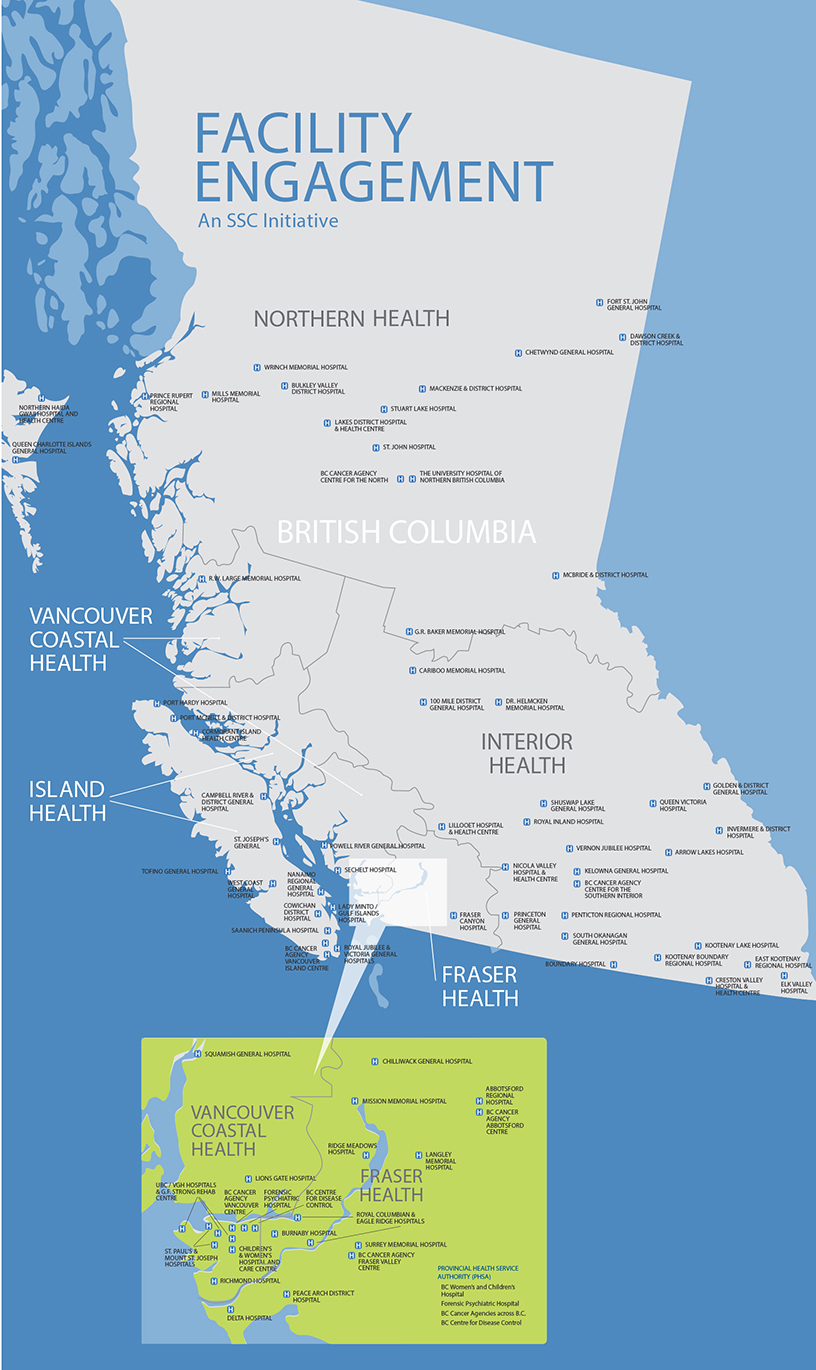Physician engagement gains traction across BC
Meaningful physician engagement is essential to a health care organization’s ability to deliver high-quality, cost-effective patient care. But for the past 2 decades—as BC’s health authorities were regionalized and doctors in hospitals became even busier with capacity and wait-list pressures—doctors and administrators have been challenged to build effective collaborative processes that ensure physicians are included in decision making about their work environment and patient care.
But now that’s changing. The Specialist Services Committee’s Facility Engagement Initiative supports physicians who work in acute care facilities across BC to establish formal structures that increase their voice and influence in their hospital and region.
Since Facility Engagement was introduced 4 years ago, 72 medical staff associations (MSAs) have partnered with their health authorities to build a new foundation for collaboration. With funding available for MSA administrative and management support and physician sessional time, MSAs are setting priorities, renewing relationships with health authority leaders, and initiating collaborative activities—more than 1400 to date.
Thanks to these efforts, the tide is starting to turn.
Facility Engagement in action
As a first step to creating a foundation for collaboration, many MSAs have improved physician-to-physician relationships. This is the most notable change associated with Facility Engagement to date, as reported in the 2019 evaluation of the initiative (www.facilityengagement.ca/evaluation). Two examples of the 160-plus activities with this goal are:
- The BC Cancer Agency’s new medical staff association created a common forum for all physicians providing cancer care to collaborate across disciplines and regions, allowing them to connect with each other, and discuss care of their patients and personal well-being.
- Internists and family doctors working at the University Hospital of Northern British Columbia in Prince George met to better understand each other’s pressures and needs, improve communication, and explore ways to increase inpatient coverage, leading to collaboration with Northern Health to create a general internal medicine unit.
Improved communication with health authorities is another notable change. Physicians, administrators, and health authority executives are meeting regularly and establishing collaborative processes. More physicians are taking on leadership roles. Progress to date is illustrated by dozens of examples, such as:
- In Comox-Campbell River, Facility Engagement opened the door to dialogue and a new working relationship between the physicians and the health authority, which led to the resolution of congestion issues during the opening of new hospital campuses.
- At Providence Health Care in Vancouver, six physician leads were selected to represent the voice of medical staff and work alongside senior health authority executives to carry out the organization’s new 7-year strategic priorities and clinical/master planning. More than 120 physicians were engaged to provide ideas and perspectives to help create the plan.
Physicians are also looking to improve their work environment and patient care, initiating more than 200 collaborative projects with hospital administrators, front-line staff, and regional health authority leaders.
- Last year, physicians at Trail’s Kootenay Boundary Regional Hospital engaged the entire hospital—from specialists to administrators to cleaners—in an extraordinary effort that reduced surgical site infections to well below the national average, and the overall hospital infection rate by 50%.
- At Lions Gate Hospital in North Vancouver, an emergency room physician engaged clinical and support staff and administration in a collaborative effort to reorganize space, processes, and manpower in the department. The changes improved patient flow and wait times, communication between doctors and nurses, and reduced in nonphysician tasks.
Physicians have also taken the opportunity to explore how they can reduce the risk of burnout and provide patient care in a healthier way. Physician health is a common theme for MSA’s facility engagement work, with more than 100 related activities underway across BC.
- A region-wide collaborative effort to stimulate action and elevate medical staff well-being as a strategic organizational/system priority is underway in Fraser Health, representing 12 acute care sites as well as divisions in the community.
- The Physician Wellness Committee at Royal Inland Hospital in Kamloops has identified a number of strategies and actions to support physician health, including a peer group that provides a safe, confidential environment for physicians to discuss challenges and critical incidents.
Facility Engagement is also supporting medical staff engagement in the implementation of electronic health records, starting with Lower Mainland hospitals that are adopting the Cerner system.
Moving forward
There is more work to be done to achieve sustained change, and further evaluation of the Facility Engagement Initiative will determine its ongoing impact. Meanwhile, physicians and health authority leaders from many parts of the province report they are making headway. They are building trust and having constructive conversations about plans and decisions that impact their hospitals, programs, and patient services.
A sense of optimism is fueling the initiative across BC as physicians enjoy renewed teamwork and make positive changes that make a difference to their work culture and their patients’ experience and care.
Read what physicians are saying about Facility Engagement at www.facilityengagement.ca/whatschanging. Read more examples of progress at www.facilityengagement.ca/stories.
—Sam Bugis, MD
Vice President, Physician Affairs and Specialist Practice
—Cindy Myles
Director, Facility Physician Engagement, Specialist Services Committee

hidden
This article is the opinion of the Specialist Services Committee and has not been peer reviewed by the BCMJ Editorial Board.
